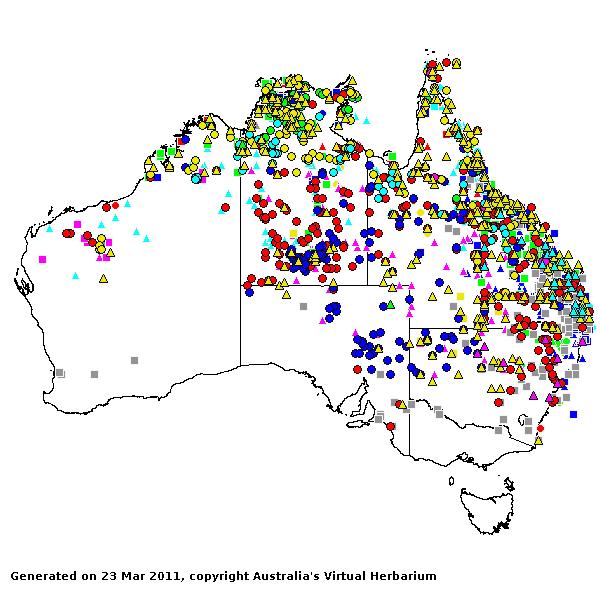Urochloa Essai Agrost. 52 (1812).
Derivation:. From Greek oura (tail) and chloe (grass), alluding to the muricate lemma of the upper floret.
Taxonomic revisions, nomenclatural references:. N.L.Bor, Grasses of Burma, Ceylon, India and Pakistan (excluding Bambuseae) pp.371–373. Pergamon:Oxford (1960);.
Key references (keys and floras):. J.W.Vickery, Flora of New South Wales, Gramineae 19: 122–124 (1961); J.C.Tothill and J.B.Hacker, Grasses of Southern Queensland 426–428 (1983); R.D.Webster, Australian Paniceae 228–255 in part (1987); T.D.Macfarlane, Flora of the Kimberley Region 1238–1242 (1992) incl. Brachiaria and Panicum maximum; B.K.Simon, Key to Australian Grasses 174 (1993); S.W.L.Jacobs and C.A.Wall, Flora of New South Wales 4: 468–472 (1993) (incl. Brachiaria except B. eruciformis); E.Edgar and H.E.Connor, Flora of New Zealand 5: 593–595 (2000); D.Sharp and B.K.Simon, AusGrass (2002) and as Brachiaria.; J.P.Jessop, Grasses of South Australia 493 (2006); S.W.L.Jacobs, R.D.B.Whalley & D.J.B.Wheeler, Grasses of New South Wales, 4th ed, 392–397 (2008).
W.D.Clayton & S.A.Renvoize, Genera Graminum (1986), genus (487).
Naturalised. 11 species, from tropical Africa, Asia. 4 species in Australia, WA, NT, SA, Qld, and NSW. Also New Zealand.
Habit. Annual or perennial, rhizomatous or stoloniferous or tufted or decumbent. Leaf blades narrow. Ligule a fringed membrane to a fringe of hairs.
Inflorescence. Inflorescence of spicate main branches (these sessile or subsessile), a racemose panicle with spikelets all similar, digitate or subdigitate or non-digitate.
Spikelets. Spikelets dorsally compressed, 2 flowered, with 1 fertile floret, solitary or paired (or in fascicles of 3 to 4), shortly pedicelled or subsessile. Fertile spikelets with lower incomplete floret(s), abaxial (with lower glume on side away from rachis) (when orientation ascertainable), falling with glumes.
Glumes. Glumes unequal or more or less equal (rarely), (the upper) long relative to adjacent lemmas, awnless, dissimilar or similar (membranous, the lower sometimes tiny). Lower glume 3 nerved. Upper glume 5–11 nerved.
Florets. Lower incomplete floret(s) male, or sterile. Lemmas awnless, 5–7 nerved (rarely more), exceeding fertile lemmas, less firm than fertile lemmas. Fertile florets 1. Lemmas decidedly firmer than glumes, rugose, becoming indurated (crustaceous), yellow in fruit, entire at apex, blunt, usually awned (or at least strongly mucronate), with a clear germination flap, 5–7 nerved, glabrous, having margins tucked into palea. Awns 1, apical, non-geniculate, hairless (scabrid or barbellate), much shorter than body of lemma. Palea relatively long, tightly clasped by lemma, entire, 2 nerved. Lodicules 2. Stamens 3. Grain small, ellipsoid to subglobose, compressed dorsiventrally. Hilum short. Embryo large.
Kranz Anatomy. C4, biochemical type PCK (4 species).
2n = 14 (U. reptans) or 28 or 30 or 36 or 42 or 44 or 48, commonly adventive.
Habitat. Mesophytic. Savanna, often weedy. Shade species, or species of open habitats (usually).
Classification. Panicoideae; Paniceae.
Notes. The genus is defined by the abaxial orientation of its spikelets, with which is associated a plano-convex shape, cuspidate tip and mucronate upper lemma. When the spikelets are paired their orientation becomes ambiguous and diagnosis then rests upon their facies. Unfortunately orientation and facies are not wholly correlated, some intermediates being noted under Brachiaria, and it is a moot point whether generic rank is justified (Clayton and Renvoize, 1986). A number of agrostologists (Webster, 1987; Macfarlane, 1992; Jacobs and Wall, 1993; Morrone and Zuloaga, 1993) have united the two genera (excluding Brachiaria eruciformis), but I feel this step is premature pending detailed cladistic work of all species (BKS).
Types Species. U. panicoides P.Beauv.
Biogeographic Element. Clifford & Simon 1981, Simon & Jacobs 1990: Gondwanan.


